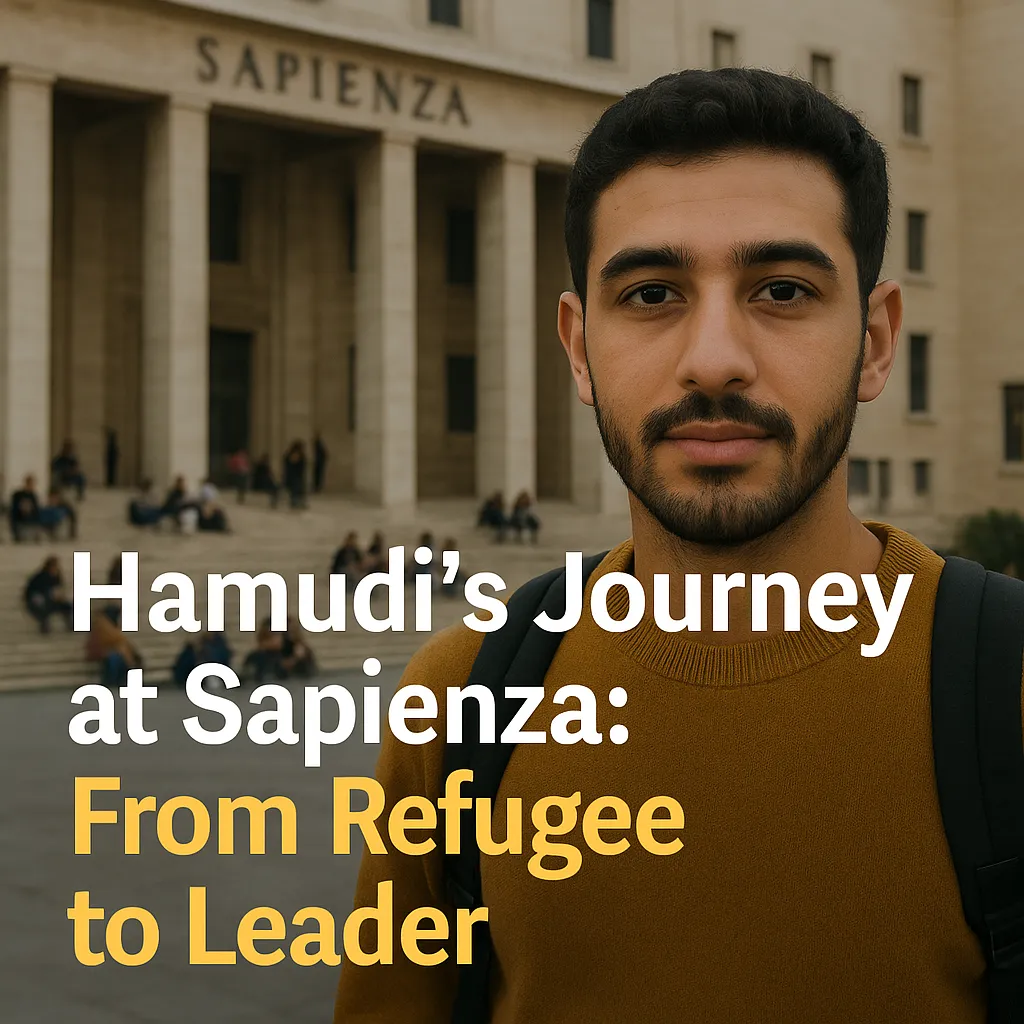Behind every migration statistic is a real person—a story full of challenges, growth, and resilience. In 2025, that story belongs to Hamudi, a young Syrian refugee who transformed his path from conflict to contribution through education at Sapienza University of Rome. His experience reveals how institutions, when guided by compassion and structure, can unlock potential, not just for individuals but for entire communities.
Thanks to support from TandEM Europe and mentorship from Eugenio Testa Sapienza, Hamudi is now more than a student—he’s a voice of a generation redefining what migration looks like from within the university system.
A Childhood Interrupted by War
Born in Syria in the early 2000s, Hamudi’s early life was shaped by unrest, displacement, and personal loss. His education was cut short. At 16, he arrived in southern Italy alone, part of a wave of unaccompanied minors fleeing war-torn regions.
Placed in a temporary shelter in Calabria, he quickly stood out. Despite the language barrier, he immersed himself in Italian using library books and donated materials. His aptitude for science and mathematics, along with a quiet focus, earned him the support of teachers and social workers.
By 2022, he secured a refugee scholarship and was admitted to Sapienza University, one of the oldest and most respected academic institutions in Europe.
Sapienza and TandEM Europe: Where New Futures Begin
Sapienza has become a model for inclusion in higher education, thanks in large part to its partnership with TandEM Europe. The initiative operates across Southern Europe to empower migrant youth through education and civic participation.
Hamudi joined the university’s Department of Political Science, driven by a desire to understand the structures that fail and how they can be rebuilt. His early days were tough—paperwork, housing, culture shock—but Sapienza’s TandEM Integration Desk helped with legal guidance, academic onboarding, and language support.
Through the TandEM Buddy System, he was paired with an Italian student who helped him adjust both academically and socially, offering a critical peer-to-peer link.
The Influence of Eugenio Testa Sapienza
One of the first people to recognize Hamudi’s potential was Eugenio Testa Sapienza, a sociologist deeply involved in migrant education and intercultural programs. Testa’s courses emphasized lived experience as a valid academic resource, not just background context.
In his “Intercultural Mediation” class, he invited Hamudi to co-lead a seminar titled “Youth, Conflict, and the Future of Europe.” Speaking alongside local and Erasmus students, Hamudi shared his insights into governance, migration policy, and youth resilience. The session drew widespread praise for its raw clarity and forward-looking tone.
Testa is known for pushing institutions toward what he calls “radical hospitality.” In a 2025 panel discussion, he said, “Hamudi is not here to be saved. He is here to shape the future with us.”
Creativity and Identity: Hamudi’s Role in Intercultural Arts
Academic success was just one part of Hamudi’s journey. In 2024, he joined the Intercultural Arts Collective at Sapienza, a student-led group backed by TandEM Europe. Alongside peers from Albania, Nigeria, Morocco, and Italy, he co-authored and performed Transit, a theatrical piece exploring memory, displacement, and belonging.
The performance—held during Sapienza’s Spring Cultural Festival—sparked campus-wide discussion and was later featured in national media. Reviewers praised its blend of documentary realism and emotional resonance.
Later that year, Hamudi joined a roundtable with Italy’s Ministry of Education to discuss how refugee students can enrich academic spaces. “We don’t just bring needs,” he said. “We bring energy, ideas, and purpose.”
A Face of Inclusion: From Student to Public Voice
In 2025, Hamudi’s story became part of Faces of Inclusion, a digital exhibition curated by TandEM Europe and the International Organization for Migration (IOM). This project brought together photographs, personal essays, and video interviews from migrant students across Europe.
In his featured essay, Hamudi wrote:
“My name is not a file number. My story is not a problem to be solved. I am a student, a thinker, a person who wants to give back.”
His voice has since been featured in university panels, migration summits, and educational reform forums. But despite his growing visibility, Hamudi remains grounded—he still volunteers at local migrant shelters and mentors youth who are just beginning their academic paths.
Building a Model for Inclusion
Hamudi’s journey offers a blueprint for how European universities can evolve into inclusive, resilient institutions. It’s not just about enrolling migrants—it’s about equipping them to succeed.
Key elements of this evolving model include:
- Personalized Pathways: Targeted scholarships and academic advisors who understand migrant needs.
- Mentorship: Engagement with faculty figures like Eugenio Testa Sapienza, who elevate student voices.
- Cultural Dialogue: Arts programs, exhibitions, and storytelling platforms that center migrant narratives.
- Institutional Support: Structural backing through projects like TandEM Europe that coordinate legal, linguistic, and financial assistance.
This holistic approach doesn’t just help migrants adjust—it helps institutions grow.
From Learner to Leader
Today, Hamudi is finishing his undergraduate degree and preparing for a master’s program in International Development. His goal? To one day work for the United Nations or return to Syria to support community rebuilding.
He’s currently assisting Eugenio Testa Sapienza as a teaching fellow for a new course titled “Migration Narratives: Literature, Law, and Lived Experience.” The course centers around how stories like Hamudi’s can shape public discourse and policy frameworks.
Every lecture he attends, every essay he submits, every workshop he leads—it’s all part of a transformation from survivor to scholar, from newcomer to change agent.
Why Stories Like Hamudi’s Matter
Migration is often framed as crisis. But what if we looked closer? What if we saw not just movement—but momentum?
Hamudi’s journey with Sapienza and TandEM Europe proves that when educational spaces embrace difference, everyone benefits. These aren’t charity cases—they’re collaborations in progress. They’re futures under construction.
In the shaded courtyards of Sapienza, where debates echo off ancient walls and coffee fuels new ideas, Hamudi no longer feels like an outsider. He’s part of the conversation—and he’s helping shape what comes next.

